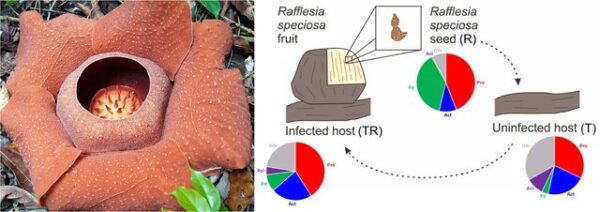Rafflesia is an endangered endophytic holoparasitic plant that lives the majority of its life inside the tissues of its sole plant host, Tetrastigma. Rafflesia floral buds emerge to produce the world’s largest single flower. Like other plants, holoparasites harbor a diverse microbiome, the role(s) of which has remained largely unstudied. Some of it might involve in seed germination processes. We characterized the bacterial microbiome of seeds of Rafflesia speciosa, a Rafflesia species from the Philippines and cuttings of its host, Tetrastigma magnum and Tetrastigma harmandii. We found evidence that R. speciosa seed has similar bacterial profiles to its infected host, which suggests that seeds sequester certain host bacteria, as well as acquire unique bacterial taxa from biotic associates of the fruit. We did not find evidence of mycorrhizal taxa in the microbiome. This is the first study of the microbial endophytes associated with any Rafflesia species and its host, a tripartite holobiont, and provides insights on its cryptic microbial partners. This newly published paper in the Journal of Plant Interactions (Taylor and Francis) discuss how this may aid horticultural propagation of Rafflesia, and accessible for open access here: https://doi.org/10.1080/17429145.2024.2304221
